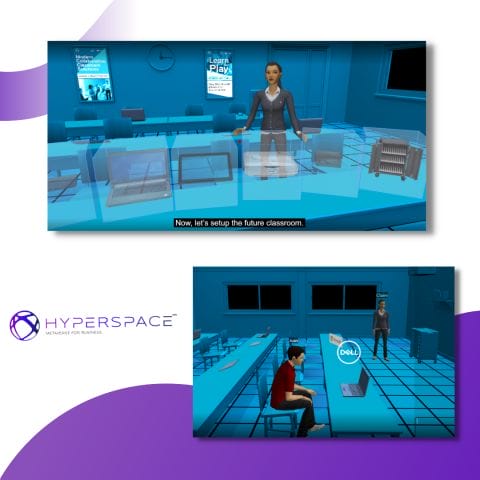In today’s fast-changing business world, companies are looking for new ways to improve their employees’ skills. One exciting method is using Virtual Reality (VR) for corporate training. This approach lets businesses create interactive learning experiences that traditional methods can’t match. VR training helps employees learn important skills and get ready for real-world challenges.
Hyperspace is a leading choice, providing ‘VR-Ready’ technology that works on any device. This is different from usual ‘VR-Only’ programs that need special hardware. It means companies can offer training that’s easy to access and fun for all kinds of employees.
Key Takeaways
- Corporate training with VR significantly enhances employee engagement and skills acquisition.
- VR training methods are proven to reduce training time by up to four times compared to conventional techniques.
- Implementing immersive learning solutions can bridge the gap between theoretical knowledge and practical application.
- VR training offers cost savings by minimizing the need for physical training facilities and materials.
- Industries like healthcare, aviation, and manufacturing benefit greatly from hands-on VR training experiences.
- Tools like Hyperspace enable organizations to deliver flexible training regardless of employee location or device.
Introduction to Corporate Training with VR

Corporate training has changed a lot, thanks to new tech. Virtual reality training is leading this change. It offers a new way to learn by making real-life scenarios come to life. This helps workers learn important skills safely and in a controlled space.
Old ways of training can make people feel bored and forget what they learned. But VR makes learning fun and interactive. Studies show VR helps people remember what they learn better than old methods.
VR is getting easier to use, with affordable headsets and tools to make content. Even though it costs money at first, it saves money in the long run. It also makes workers more effective. VR lets training fit the needs of different workers, no matter their learning speed.
Fields like healthcare, manufacturing, and construction really benefit from VR training. It lets workers practice without risk. Companies need to think about what they want to achieve with VR before starting. With the right tools and help from VR experts, they can make training that really gets workers excited.
| Aspect | Traditional Training | VR Training |
|---|---|---|
| Engagement Level | Passive | Active |
| Cost Per Employee | $1,500 – $5,000 | Varies by Program |
| Retention Rate Increase | Standard | 30% – 50% |
| Environment Safety | Risky for Practical Skills | Risk-Free |
| Technology Accessibility | Less Flexible | Highly Scalable |
This new way of training boosts worker confidence and skill. It also makes companies perform better. With VR, companies are changing how they teach their workers.
Understanding Virtual Reality Training

Virtual Reality (VR) training mixes advanced tech with fun learning methods. It gives employees real and engaging learning experiences. This changes how we train, making it better for learning and skills.
Definition and Importance of VR Training
VR training is a type of immersive learning solutions that mimics real-world situations. It lets learners practice important skills safely. Studies show VR training boosts confidence by up to 275% over old methods.
It also helps people remember important info and stay safer at work.
The Technology Behind VR Immersive Learning
The tech behind VR learning includes top-notch graphics, motion tracking, and feedback systems. These work together to make scenarios feel real. The right VR hardware, like modern headsets, is key for good training.
Companies like Verizon and Tower Hill Insurance have seen great results. They’ve improved engagement and learning with VR.
VR training gives instant feedback, helping learners improve. This feedback helps companies make their training better. VR combines old and new methods, fitting different learning styles. Learn more about VR with immersive learning solutions.
Benefits of Corporate Training with VR
VR training in corporate programs brings many benefits. It makes learning more engaging and effective. This leads to better knowledge retention and faster learning, helping companies grow.
Enhanced Employee Engagement
VR training grabs employees’ attention in ways old methods can’t. It’s key for learning, and studies show 61% of users get job skills better through VR. VR makes employees more active in their learning, keeping them engaged.
Improved Knowledge Retention
VR training boosts knowledge retention a lot. It’s 75% effective, compared to 5% for lectures. This means employees remember and use what they learn well. Companies like HQSoftware see 67% retention with VR.
Accelerated Learning Processes
VR training speeds up learning by letting employees practice in safe scenarios. This quickens onboarding and boosts confidence. It’s also 52% cheaper than classroom training, saving businesses money.
Comparison of VR Training vs. Traditional Training
The world of corporate training is changing fast. Immersive tech like VR is making a big impact. It’s important to compare VR training with traditional online learning.
Immersion vs. Online Learning
Traditional online learning is flexible but not as engaging as VR. VR training makes learning more fun and interactive. It helps employees remember what they learn better.
VR training lets employees practice in safe, real-like settings. This makes learning safer and more effective.
Real-World Applications of VR Training
VR training is useful in many fields. It helps healthcare workers get ready for tough procedures safely. It also helps customer service teams practice in stressful situations.
Big companies like Toyota and Coca-Cola use VR training. They see big improvements in productivity and fewer mistakes. VR training can be tailored to fit specific needs, making it a great choice for companies.
| Aspect | VR Training | Traditional Training |
|---|---|---|
| Engagement | High due to immersive experiences | Moderate, can be less interactive |
| Knowledge Retention | 75% improvement in retention | Limited retention after a few days |
| Real-World Application | Simulates real-life scenarios | Less realistic, theoretical focus |
| Cost-Effectiveness | Lower long-term costs due to scalability | Higher due to materials and instructor fees |
| Customization | Highly customizable training environments | Limited customization options |
Types of Corporate VR Training Programs
Corporate VR training programs use virtual reality to improve employee skills and teamwork. They help in developing skills, building team unity, and making onboarding more engaging. This is done in a way that’s both dynamic and interactive.
Soft Skills Development
Soft skills training is becoming more popular with VR. It lets employees practice important social skills in a real-life setting. Topics like communication, empathy, and conflict resolution are covered.
This approach helps employees connect emotionally with the learning. It also makes them remember what they learn better. Studies show VR training can improve learning retention by up to 80%.
Team Training and Workshops
VR training is great for team building. It creates shared virtual experiences that boost problem-solving and creativity. This way, teams from different places can work together smoothly.
Companies see a 10-15% increase in staff confidence after VR training. This improves how well teams work together.
Onboarding and HR Training
VR is changing how companies onboard new employees. It helps them learn about the company culture and practices quickly. This makes onboarding faster and more effective.
Companies using VR for HR training find their employees feel more confident. For example, Bank of America saw a 97% increase in employee confidence after VR training.
VR Training Solutions in Various Industries
VR training is changing the game in many fields. It’s making healthcare, aviation, manufacturing, retail, and customer service better. This tech lets workers practice in safe, real-life scenarios.
Healthcare
VR is changing medical training. It lets doctors practice without risk. This makes them better at their jobs and keeps patients safe.
Studies show VR helps people remember things better than classroom learning. It’s why many schools choose VR for training.
Aviation and Manufacturing
VR is key for aviation training. It lets teams practice without danger. This makes them ready for real tasks.
In manufacturing, VR boosts safety and efficiency. Companies like DHL use it for training. It helps them work better without stopping their daily tasks.
Retail and Customer Service
Retail is using VR to train employees. Walmart uses it to prepare for busy times. It helps workers learn to handle customers better.
In customer service, VR gets workers ready for real situations. It makes them more confident and ready to help customers.
Challenges of Implementing VR Training
VR training comes with its own set of challenges for companies. The cost of VR training is a big factor, with initial costs being high. This includes the cost of creating custom content and buying the right technology. Companies need to weigh the long-term benefits against the VR training expenses upfront.
Cost Considerations
The cost of adapting VR training is a major concern. While the initial costs are high, there are savings to be made. For example, PwC found that VR training can cut training time in half compared to old methods. This means less money spent on training over time.
Walmart is a great example. They cut training time from 30-45 minutes to just 3-5 minutes. This makes training cheaper for a lot of employees.
Acceptance and Adaptation by Employees
Getting employees to accept VR training is another big challenge. Many are not used to this technology and may be hesitant. To help, companies need to teach employees about VR’s benefits. This includes how it can improve learning and keep people engaged.
Using hands-on demos and explaining the benefits can help make VR training welcome. This way, it becomes a valued part of training programs.
How to Get Started with Corporate VR Training
Starting with corporate VR training can change how companies train employees. The first step is to figure out what training is needed. This ensures the VR training meets the right needs.
Knowing the skills gaps in the workforce helps tailor VR training. This makes the training more effective and engaging for everyone.
Assessing Training Needs
After identifying the training needs, it’s time to pick a VR training provider. This choice is key to the success of VR training. Look for a provider with experience, good technology, and support.
It’s important to find a provider that fits your training goals. They should also make integrating VR training easy.
Choosing the Right VR Training Solutions Provider
By assessing needs and choosing the right provider, businesses can create great immersive learning experiences. This approach boosts learning outcomes and keeps the company ahead in training.
With VR training getting easier to use, companies can see faster adoption and better performance. This innovative method is a game-changer for employee training.





